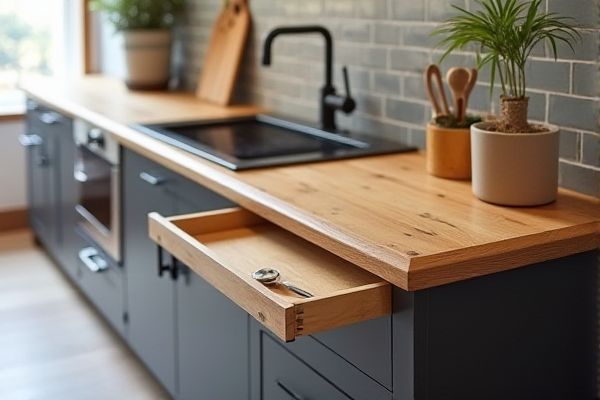
Pull-out utility tables offer a sturdy, space-saving solution by sliding out from a fixed base, making them ideal for permanent workspaces, while fold-up tables provide portability and easy storage by folding flat against a wall or frame. Discover which option fits your needs best by exploring the detailed comparison in the rest of the article.
Table of Comparison
| Feature | Pull-Out Utility Table | Fold-Up Table |
|---|---|---|
| Design | Sliding mechanism, extends from existing furniture | Hinged legs or panels that fold flat against wall or furniture |
| Space Efficiency | Compact, hidden within cabinetry when not in use | Highly space-saving, folds flat vertically or horizontally |
| Setup Time | Quick slide out, minimal assembly | Simple unfolding, no tools required |
| Stability | Generally sturdy, anchored within cabinetry | May vary, dependent on locking mechanisms |
| Typical Use | Kitchen prep, workspace extension | Temporary dining, laptop or craft table |
| Installation | Built-in, requires fitting into cabinets or furniture | Wall-mounted or free-standing options available |
| Weight Capacity | Moderate to high, depending on build quality | Moderate, varies by design and materials |
| Cost | Typically higher due to installation complexity | Generally affordable and easier to install |
Introduction to Space-Saving Tables
Pull-out utility tables provide a compact solution by sliding out from existing furniture, maximizing floor space without permanent fixture requirements. Fold-up tables feature hinged designs that collapse flat against a wall or cabinet, offering versatile usage in small spaces. Both options enhance room functionality by combining efficient storage with practical surface area expansion.
Overview: Pull-Out Utility Table vs Fold-Up Table
Pull-out utility tables maximize space by sliding neatly from existing furniture or cabinetry, offering a sturdy, accessible work surface ideal for small rooms or kitchens. Fold-up tables fold flat against the wall and can be easily lifted into use, providing versatile, space-saving solutions perfect for temporary tasks or dining areas. Your choice depends on available space and how frequently you need a quick, reliable table setup.
Design and Installation Differences
Pull-out utility tables feature a sliding mechanism that allows the table to be extended from a built-in cavity, optimizing space by remaining hidden when not in use, requiring precise installation within cabinetry or walls. Fold-up tables mount directly to walls or surfaces with hinges, enabling you to fold the table vertically, which demands secure anchoring and sufficient wall support to handle weight. Your choice between these tables depends on whether you prefer a sleek, integrated design with complex installation or a simpler, space-saving option with straightforward mounting.
Space Optimization and Storage
Pull-out utility tables maximize space optimization by sliding seamlessly from cabinetry or under countertops, providing an instant work surface without occupying permanent floor space. Fold-up tables excel in storage efficiency since their hinged design allows them to collapse flat against walls or furniture, freeing up valuable room when not in use. Both solutions enhance small living areas, but pull-out tables offer smoother integration into built-in storage, whereas fold-up tables provide versatile placement options.
Ease of Use and Accessibility
Pull-out utility tables provide seamless access by sliding horizontally, making them ideal for quick deployment and minimal effort, especially in tight spaces. Fold-up tables require lifting and securing, which may be less convenient for frequent use but offer versatile storage by folding flat against a wall or cabinet. Your choice depends on prioritizing effortless accessibility with pull-out designs or compact storage benefits with fold-up options.
Durability and Maintenance
Pull-out utility tables often feature robust materials like solid wood or metal frames, enhancing durability under frequent use and heavy loads. Fold-up tables typically use lighter materials such as aluminum or plastic, making them less durable but easier to maintain and clean due to their compact design. Maintenance for pull-out tables may involve periodic lubrication of sliding mechanisms, whereas fold-up tables require regular inspection of hinges and joints to ensure long-term functionality.
Aesthetic Appeal and Customization
Pull-out utility tables offer sleek integration with existing cabinetry, enhancing aesthetic appeal by maintaining a clean, minimalist look that can be customized with materials matching kitchen finishes. Fold-up tables provide versatile design options with visible hinges and support mechanisms, allowing for varied sizes, shapes, and finishes that adapt to different interior styles. Customization in pull-out tables typically involves tailored dimensions and finishes for seamless blending, while fold-up tables offer greater flexibility in positioning and multi-functional design elements.
Cost Comparison
Pull-out utility tables generally cost more than fold-up tables due to their complex installation and durable materials designed for heavy-duty use. Fold-up tables are often more budget-friendly, offering a cost-effective solution with easier installation and portability. Your choice depends on balancing long-term durability and upfront expense, with fold-up tables providing affordability and pull-out models delivering robust functionality.
Best Use Cases for Each Table Type
Pull-out utility tables excel in space-saving efficiency and are ideal for compact kitchens or workspaces needing occasional extra surface area for meal prep or crafts. Fold-up tables suit flexible environments such as multipurpose rooms or garages, allowing users to quickly create work or dining space and then neatly store the table flat against a wall. Choosing between the two depends on the frequency of use and available space, with pull-out tables offering a semi-permanent extension and fold-up tables providing maximum portability and ease of storage.
Final Verdict: Which Table Suits Your Needs?
Pull-out utility tables provide sturdy, space-saving functionality perfect for heavy-duty tasks and frequent use, while fold-up tables offer lightweight portability and easy storage ideal for occasional or mobile needs. Your choice depends on whether you prioritize durability and permanent installation or flexibility and compactness. Consider your space constraints and usage frequency to determine which table best suits your lifestyle and work habits.
 homyna.com
homyna.com